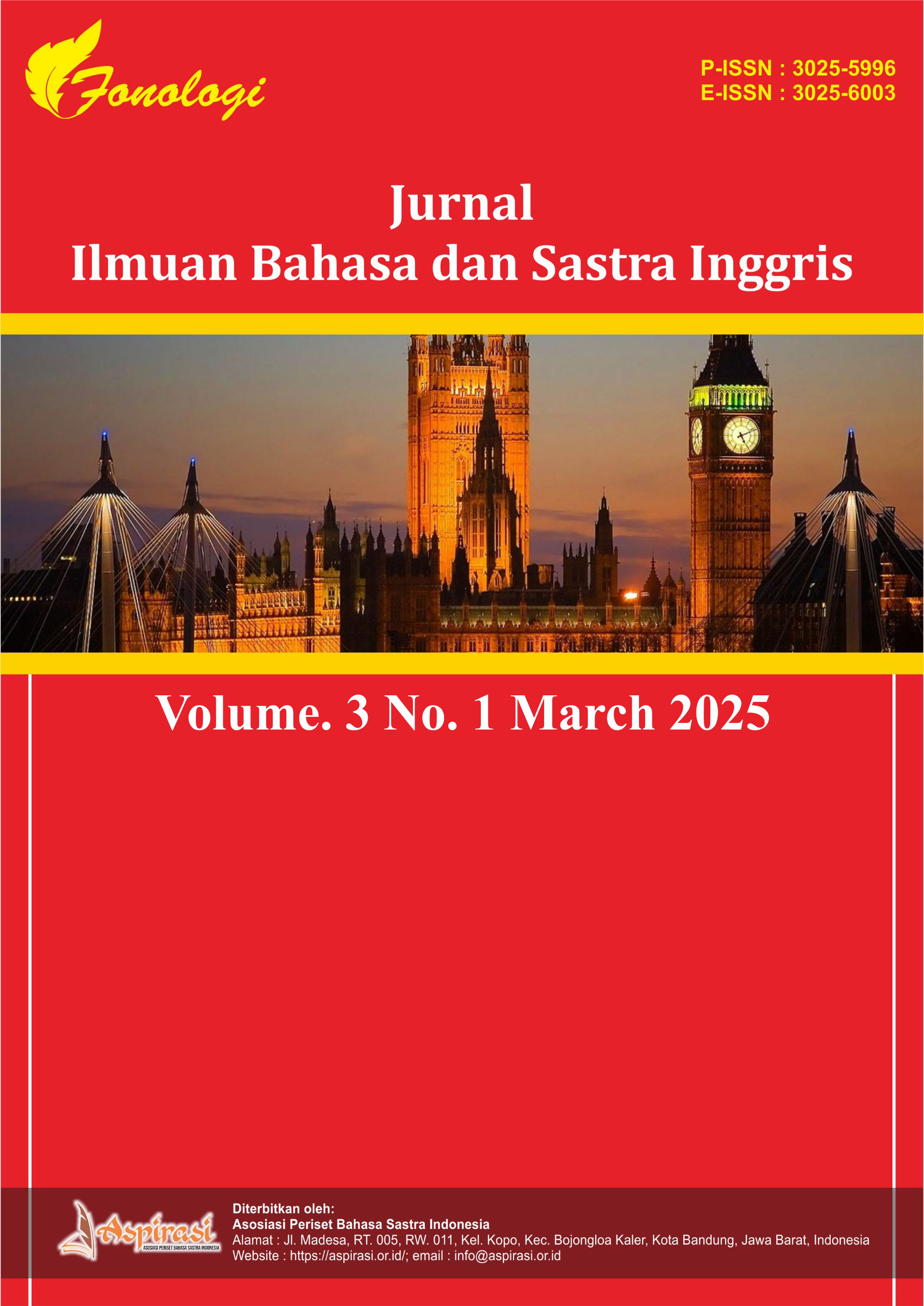Uncovering the Power of Educational Websites as a Means of English Language Learning: Students’ Perspective
DOI:
https://doi.org/10.61132/fonologi.v3i1.1333Keywords:
Literacy Websites, Power, FacilitiesAbstract
Technology is essential to the efficient teaching and learning process. But technological advancement does not ensure that everyone can take full use of it. Acquiring technical literacy or knowing how to utilize it involves more than just learning how to read; it also involves being able to use, access, and integrate technology into the teaching and learning process. Although a lot of people use the internet, not everyone is able to fully utilize its benefits, particularly in the field of education. Learning can be done more quickly and in a number of ways, particularly while learning English. In our nation, English is a foreign language, and students will have a lot of trouble using it. Therefore, in order to help students understand and avoid becoming disinterested in the process of learning English, teachers need to possess additional skills. As a result, providing the internet and educational websites as resources for learning English will benefit both educators and learners. While the use of the internet for educational purposes is not new in our nation, not all institutions are able to put it into practice because of a lack of necessary resources, including computer equipment and internet access.
Downloads
References
Adnan, M. (2017). Perceptions of senior-year ELT students for flipped classroom: A materials development course. Computer Assisted Language Learning, 30(3–4), 204–222. https://doi.org/10.1080/09588221.2017.1301958
Agarwal, M.K. (2010). Internet-based language learning and teaching. Diakses dari: http://www.kolegija.lt/en/_turinys/Agarwal-3-7-%20IITSBE-2010-1(8).pdf
Al Arif, T.Z., Armiwati, & Handayani, R. (2023). The use of ICT for English language learning: A mixed-method study of EFL university students. Available at https://www.researchgate.net/publication/375230167_The_Use_of_ICT_for_English_Language_Learning_A_Mixed-Method_Study_of_EFL_University_Students
Albirini, A. A. (2006). Teacher’s attitudes toward information and communication technologies: The case of Syrian EFL teachers. Journal of Computers and Education, 47, 373-398.
Alexander, B. (2006). IB 2.0. A new wave of innovation for teaching and learning. Educause Review, 41(2), 32–44.
Amindri, D. (2019). Students’ perception on the benefit of English sites to improve English reading comprehension. Available at https://repository.ar-raniry.ac.id/id/eprint/8933/1/skripsxi%20lengkap.pdf
Anwar, I. W., & Sailuddin, S. P. (2022). Academic reading difficulties in higher education. Journal of Languages and Language Teaching, 10(2), 309-314. https://doi.org/10.33394/jollt.v10i2.4849
APJIII. (2024). APJII Jumlah Pengguna Internet Indonesia Tembus 221 Juta Orang. Available at https://apjii.or.id/berita/d/apjii-jumlah-pengguna-internet-indonesia-tembus-221-juta-orang
Badeleh, A., & Sheela, G. (2011). The effects of Information and Communication Technology based approach and laboratory training model of teaching on achievement and retention in chemistry. Diakses dari http://www.cedtech.net/articles/23/234.
Baylor, A., & Ritchie, D. (2002). What factors facilitate teacher skill, teacher morale, and perceived student learning in technology-using classrooms? Journal of Computers & Education, 39(1), 398.
Belawati, T. (2003). Indonesia: ICT use in education. In UNESCO Meta-survey on the Use of Technologies in Education. Available at https://unesdoc.unesco.org/in/documentViewer.xhtml?v=2.1.196&id=p::usmarcdef_0000134960&file=/in/rest/annotationSVC/DownloadWatermarkedAttachment/attach_import_10786df3-0d0d-4238-bd78-088fb7819895%3F_%3D134960eng.pdf&locale=en&multi=true&ark=/ark:/48223/pf0000134960/PDF/134960eng.pdf#%5B%7B%22num%22%3A479%2C%22gen%22%3A0%7D%2C%7B%22name%22%3A%22XYZ%22%7D%2C-215%2C849%2C0%5D
Bouchrika, I. (2024). 50 useful links for learning and teaching English in 2024: Websites, articles, and resources. Available at https://research.com/education/useful-links-for-learning-and-teaching-english-and-teaching
Davies, G. (2008). Information and communications technology for language teachers (ICT4LT). Slough, Thames Valley University. Available at http://www.ict4lt.org
Finaka, W.A., Nurhanisah, Y., & Devina, C. (2023). Orang Indonesia makin melek internet. Available at https://indonesiabaik.id/infografis/orang-indonesia-makin-melek-internet
Harlinda, N. (2019). Students’ perception in using YouTube as media for learning English as a foreign language. Thesis, English Education Department, Teacher Training and Education, Palangka Raya: IAIN Palangka Raya.
Hazari, A. (2014). Learning curve: Student perceptions have a huge impact on understanding. Available at https://www.scmp.com/lifestyle/family-education/article/1407745/learning-curve-student-perceptions-have-huge-impact
Huda, C., M. Jannataka, N., & Prayoga, A. N. (2023). Exploring the use of online resources for English language learning: Students’ perspectives. Available at https://www.researchgate.net/publication/374320653_EXPLORING_THE_USE_OF_ONLINE_RESOURCES_FOR_ENGLISH_LANGUAGE_LEARNING_STUDENTS'_PERSPECTIVES
Izadpanah, S., & Alavi, M. (2016). Student-engaged viewpoint on technology in learning English in Zanjan public high schools. Theory and Practice in Language Studies, 6(4), 854-860. Available at https://www.academypublication.com/issues2/tpls/vol06/04/25.pdf
Kajeet. (2024). Top 25 educational websites students actually visit. Available at https://www.kajeet.com/en/blog/updated-top-educational-websites-your-students-actually-visit
Kellner, D. (2000). New technologies/new literacies: Reconstructing education for the new millennium. Teaching Education, 11(3).
Maddel, D., & Muncer, S. (2005). Are internet and mobile phone communication complementary activities amongst young people? A study from a ‘rational actor’ perspective in Information, Communication and Society, 8(1), 64-80. https://doi.org/10.1080/13691180500066888
Nurhasanah, Sulistyo, B., Agustiani, M., & Ulya, E. N. (2015). Students’ perceptions on the use of internet as learning media in reading classroom. Journal Basis, 12(9), 111–120. https://doi.org/10.33884/basisupb.v7i1.1864
Nurhayati, H. (2024). Internet usage in Indonesia—Statistics and facts. Available at https://www.statista.com/topics/2431/internet-usage-in-indonesia/#topicOverview
Orgaz, F., Moral, S., & Domínguez, C. M. (2018). Student’s attitude and perception with the use of technology in the university. Propósitos y Representaciones, 6(2), 253-299. https://doi.org/10.20511/pyr2018.v6n2.230
Rice, R.E., & Haythornthwaite, C. (2006). Perspective on internet use: Access, involvement, and interaction. In S. Lievrouw & S. Livingstone (Eds.), Handbook of new media (pp. 92-113). London, Thousand Oaks, New Delhi: Sage Publications. Available at https://www.hoepli.it/editore/hoepli_file/download_pub/978-88-203-3344-7_Chapter4.pdf
Rogers, E. M. (2003). Diffusion of innovations (5th ed.). Free Press.
Suryani, A. (2006). Exploring the internet usage for English language learning. Jurnal Ilmu Komunikasi, 3(2), 101-117. Available at https://media.neliti.com/media/publications/301596-exploring-internet-usage-for-english-lan-3a775e6d.pdf
Swenson, et al. (2006). Extending the conversation: New technologies, new illiteracies, and English education. English Education, 38(4), 351. Retrieved October 21, 2006, from http://proquest.umi.com.ezproxy.lib.monash.edu.au/pqdweb?index=6&sid=1&srchmode=3&vinst=PROD&fmt=6&startpage=-1&clientid=16397&vname=PQD&RQT=309&did=1094507851&scaling=F
Wahyuni, S., & Hakiki, E. B. (2023). Students’ perception on the use of web-based technology for learning English skills at university. ELITE Journal, 5(1), 183-194. Available at https://www.google.com/search?q=students+perception+towards+teh+use+of+internet+in+language+learning&rlz=1CAVRVC_enID1042&oq=students+&gs_lcrp=EgZjaHJvbWUqBggCEEUYOzIGCAAQRRg7MgcIARAAGIAEMgYIAhBFGDsyBggDEEUYOTIHCAQQABiABDIHCAUQABiABDIHCAYQABiABDIHCAcQABiABDIHCAgQABiABDIHCAkQABiABNIBCTc3NzJqMGoxNagCCLACAQ&sourceid=chrome&ie=UTF-8#:~:text=Students%27%20Perception%20on,ELITE%20%E2%80%BA%20article%20%E2%80%BA%20download
Downloads
Published
How to Cite
Issue
Section
License
Copyright (c) 2025 Fonologi : Jurnal Ilmuan Bahasa dan Sastra Inggris

This work is licensed under a Creative Commons Attribution-ShareAlike 4.0 International License.





